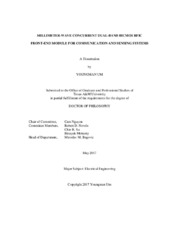| dc.description.abstract | This dissertation presents new circuit architectures and techniques for improving several key performances of BiCMOS RFIC building blocks that are used in wireless communication and sensing systems operating at millimeter-wave frequencies. The developed circuits and front-end module can be employed in concurrent dual-band transceivers for communication and sensing systems such as phased array and RFID systems.
New 0.18-μm CMOS dual-bandpass filtering single-pole double-throw (SPDT) and transmit/receive (T/R) switches have been developed, and they operate in two different frequency bands centered at around 40 and 60 GHz (Design 1) and 24 and 60 GHz (Designs 2, 3 and 4). Design 1 is a concurrent dual-bandpass filtering T/R switch consisting of three SPDT switches based on a 3rd order band-pass filter with shunt nMOS transistors as the switching function. Design 2 is a 24/60-GHz concurrent dual-bandpass T/R switch consisting of dual-band λ/4 LC networks and resonators with shunt nMOS transistors as the switching function. Design 3 is a dual-band SPDT and T/R switches, which are capable of band-pass filtering as well as separate and concurrent switching operations in single/dual-band and transmission/reception. These components can act as diplexers with switching functions. Design 4 is a wideband concurrent dual-band SPDT switch with integrated dual-bandpass filtering, which is configured to make it approximately equivalent to a dual-band resonator in the on-state operation.
A fully integrated 24/60-GHz concurrent dual-band LNA utilizing a dual-band LC circuit has been proposed. The LNA is based on a two-stage cascode topology with inductive degeneration. The dual-band LC circuit has the quarter-wavelength characteristic at two different frequencies, and it shows the dual pass-band and single stop-band characteristics when it is connected to the ground in shunt. Due to the cancellation of the stop-band signal and low-pass response by the LC circuit connected to the cascode nodes of the 1st and 2nd stages in the LNA, the LNA presents high stop-band rejection and good gain balance at 24 and 60 GHz.
A concurrent dual-band front-end module (FEM) consisting of a 24/60-GHz dual-band antenna, a five-port T/R switch, two LNAs and one PA has been proposed. The FEM can be employed in systems with dual-polarization, for instance, phased array and RFID reader systems. | en |


